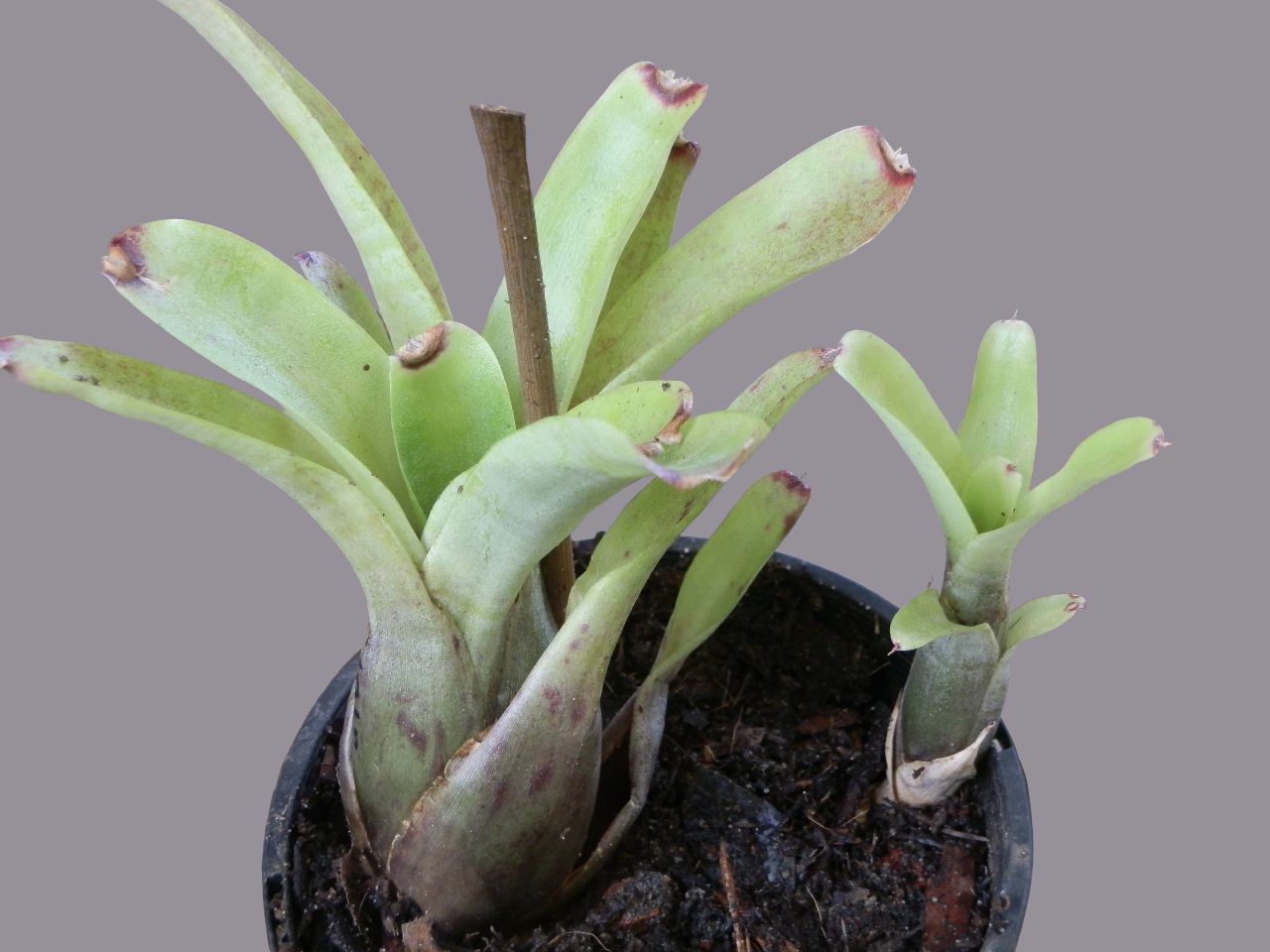
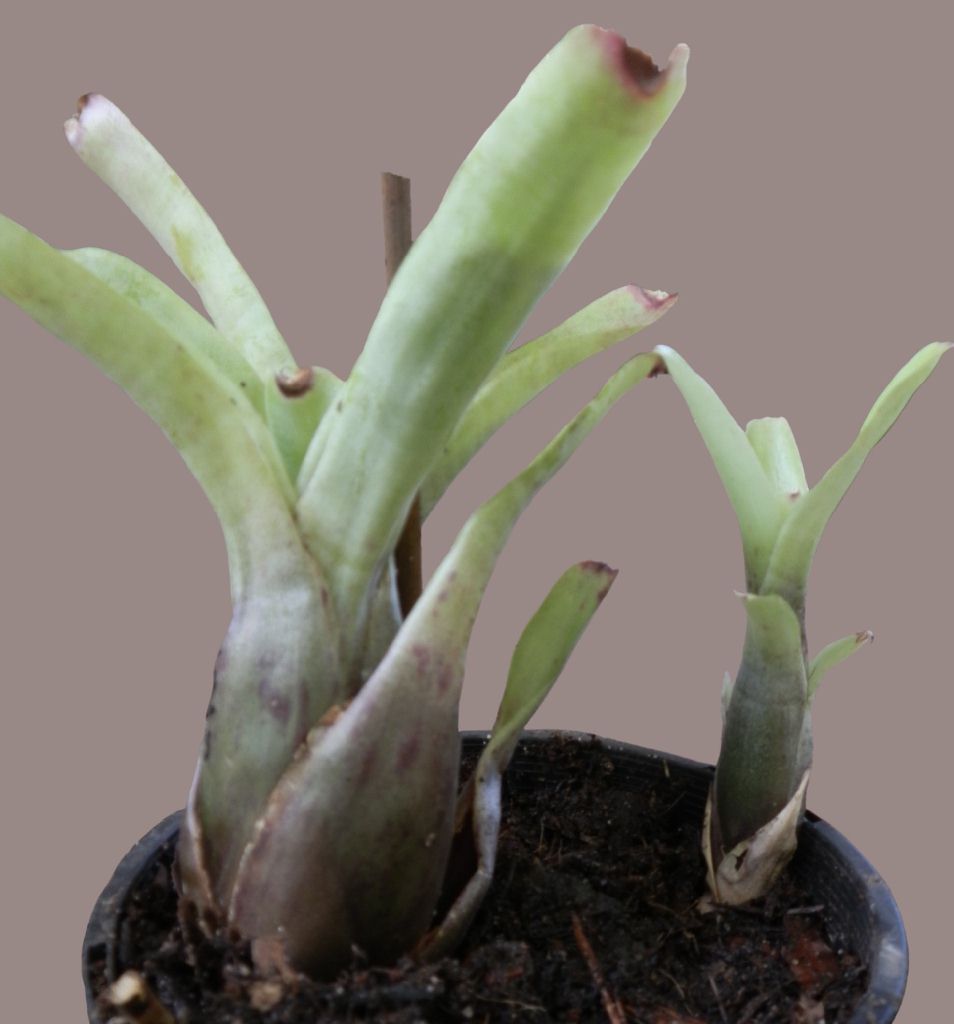
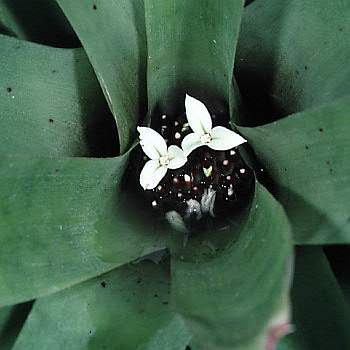
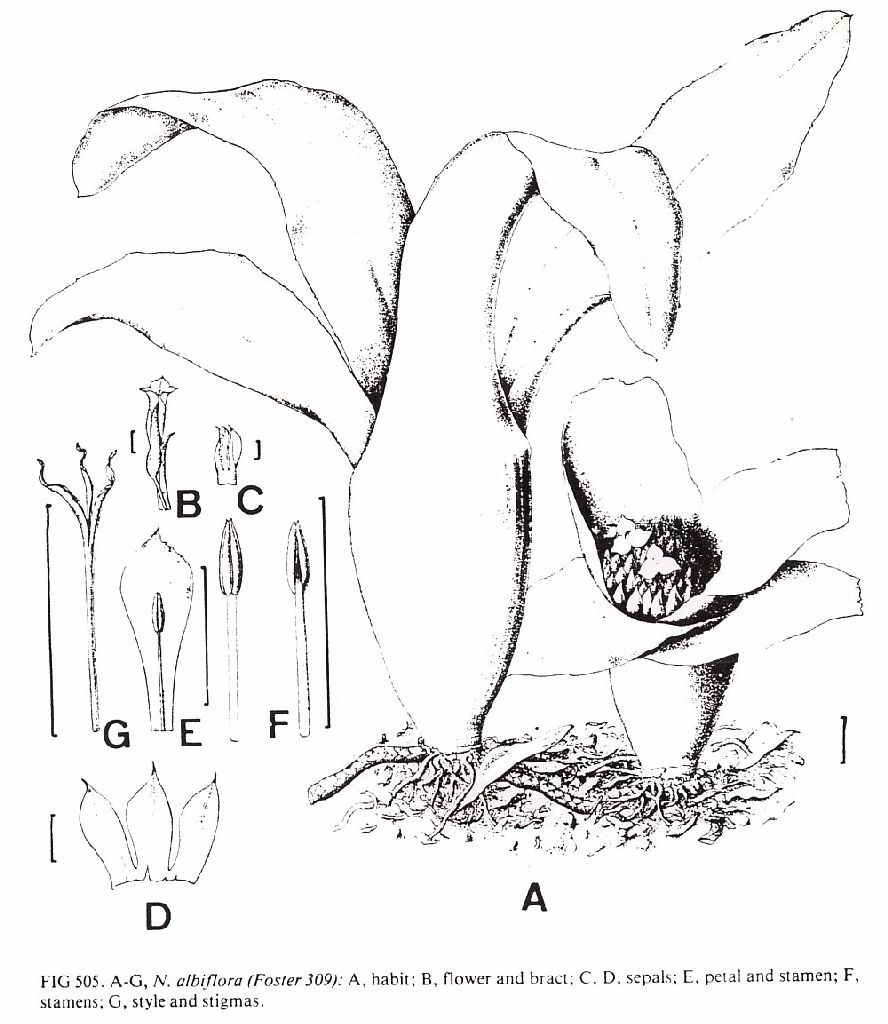
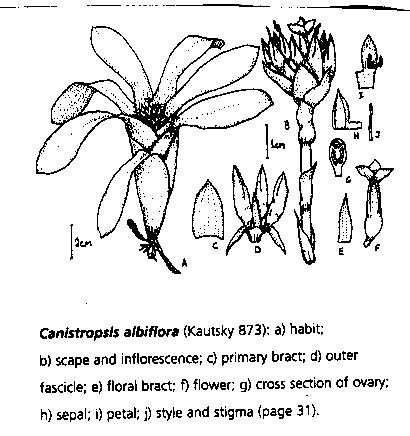
Canistropsis albiflora (L. B. Sm.) H. Luther & Leme, Canistropsis – Brom. Atl. Forest. 31-32. 1998
Basionym: Neoregelia albiflora L. B. Sm., Arq. Bot. Estado Sao Paulo 1 (5): 109-110,pl.113.1943.
Synonym: Nidularium lymanioides E. Pereira & Leme, Bradea 4 (32): 229, fig. 7. 1986.
Type: Espirito Santo, Domingos Martins, 21 Oct.1985, R. Kautsky 873 (HB).
PLANT epiphytic, propagating by stolons ca. 10 cm long, ca. 0.3 cm in diameter.
LEAVES 6 to 12, green with very sparse darker green spots, very thin in texture forming at base a subtubular-ellipsoidal rosette;
SHEATHS elliptic, 6-10 x 3-5 cm, sparsely brown-lepidote mainly abaxially;
BLADES sublinear, narrowed toward base, 13-20 x (2.4-) 4-4.5 cm, glabrescent, suberect to near spreading, apex acute to subrounded and minutely apiculate, margins subdensely but very inconspicuously spinulose, spines less than 0.5 mm in length;
SCAPE 4-6 cm long, 3-5 mm in diameter, whitish, glabrous, covered by leaf-sheaths;
SCAPE BRACTS broadly ovate to suborbiculate, apex rounded and distinctly apiculate, 10-20 x 8-15 mm, serrulate toward apex, inconspicuously and sparsely brown-lepidote, whitish, membranaceous.
INFLORESCENCE subcorymbose, subglobose-capitate, bipinnate, barely visible in the rosette, 20-30 mm in diameter;
PRIMARY BRACTS oblong-ovate to suborbiculate, suberect, 15-20 x 10-15 mm, inconspicuously and sparsely lepidote, trichomes entire, green, apex broadly acute to obtuse and apiculate, equalling the basal portion of the sepals, margins entire to remotely spinulose, spines irregularly curved;
FASCICLES 3 to 6, 30 mm long, ca. 3-flowered, peduncle complanate, glabrous;
FLORAL BRACTS narrowly ovate, apex acute and apiculate to acuminate, ca. 14 x 4 mm, entire to remotely spinulose, ecarinate, membranaceous, hyaline to greenish toward apex, glabrescent, from equalling the ovary up to the base of the sepals.
FLOWERS 24-28 mm long, weakly fragrant, pedicels inconspicuous, 2-4 (-7) mm long;
SEPALS asymmetrical, oblong-ovate, apex acute and apiculate, ca. 13 x 5 mm, connate for ca. 1 mm, glabrous, green, ecarinate;
PETALS lanceolate-spatulate, 13-15 x 5 mm, connate for 3-4 mm apex acute, white with a green central portion, spreading at anthesis, then becoming suberect, flaccid and pale brown-colored, bearing two longitudinal callosities;
ANTHERS linear, ca. 4 mm long. base obtuse and apex apiculate, dorsifixed at the middle;
STIGMA ellipsoid, white, surpassing the anthers;
OVARY obovate, subtrigonous, 6-10 mm long, white, glabrous; ovules cylindraceo- apiculate.
FRUITS unknown.
TYPE: Espirito Santo, Santa Tereza. 28 Jun. 1939, M. B. & R Foster 309, fl. cult. 1 Nov. 1939. Holotype: GH.
DISCUSSION
Lyman B. Smith (1943) originally described this species in the genus Neoregelia, but he did not indicate a close relationship with any of the other known species. As distinguishing characteristics he cited the "delicate nature" of the plant, its small size and unusual light green color, and the acuminate floral bracts. More importantly however, in his description Smith did not mention the branched condition of the inflorescence, which was verified only recently after analyzing the holotype. If, on the one hand, this omission is understandable because of the indistinct nature of these lateral branches, on the other, it contributed to the mistaken identification of this species for many years. This, in turn, led to the dissemination of a flawed concept of the taxon in spite of the beautiful drawing that is part of the protologue, which shows the habit and flower details of this species. As a consequence, Nidularium lymanioides, whose branched inflorescence indicated from the beginning that it belonged in Canistropsis, was described unnecessarily and is placed in synonymy here.
As Smith (1943) observed, this is the most delicate-textured species within the genus Canistropsis. The unique subtubular ellipsoidal leaf rosette reminds one of a typical representative of the genus Lymania, whence the name, N. lymanioides, placed in synonomy here. Canistropsis albiflora and C. simulans are obviously related morphologically. Besides the delicate texture of the leaves and the unusual shape of the leaf rosette, C. albiflora differs from C. simulans in the nearly rounded apex of the leaf blades which is provided with a tiny apiculus and in the entire to almost entire floral bracts and glabrous sepals.
DISTRIBUTION & HABITAT
The extremely delicate texture of the leaves of C. albiflora mirrors its requirement for very wet habitats such as those of the montane Atlantic forest region of Espirito Santo and the coastal tableland forests ("tabuleiros") of Bahia, where it grows. This species is very sensitive to even the shortest period of drought that may quickly lead to the death of the plants. C. albiflora is naturally quite rare in the wild; it is very sparsely distributed even within its area of occurrence.
C. albiflora grows only as an epiphyte in the understory of slope forests, usually at altitudes over 500 m. It has the same vegetative growth strategy as species of Lymania; small groups of plants spread spirally by delicate stolons on the stems of shrubs and on slender tree branches. Plants flower from November to January. This species has yet to be recorded in conservation units, but there are two or three documented clones in cultivation, in Brazil and overseas.
From S&D
48. Neoregelia albiflora L. B. Smith, Arq. Bot. S. Paulo II. l: 109, pl. 113. 1943.
Plant propagating by basal rhizomes. Leaves 4-6 in a slenderly funnelform or sub-cylindric but never constricted rosette, 20 cm long; sheaths broadly elliptic, entire, about half as long as the blades, sparsely brown-lepidote; blades ligulate, broadly rounded and apiculate, 24 mm wide, thin, laxly serrulate with spines less than 0.5 mm long, wholly green when dry, obscurely white-banded beneath in life, sparsely and very obscurely pale-lepidote. Scape slender, 4 cm long; scape-bracts membranaceous. Inflorescence simple, few-flowered, deeply sunk in the center of the rosette; outer bracts elliptic, apiculate, slightly exceeding the ovaries, minutely serrulate toward apex, membranaceous, pale. Floral bracts lanceolate, acuminate, slightly exceeding the ovary, membranaceous, obscurely serrulate toward apex; pedicels 5-7 mm long; flowers to 24 mm long. Sepals sublanceolate, asymmetric, acuminate, 13 mm long, connate for 1 -2 mm, green; petals slightly exceeding the sepals, white, much exceeding the stamens; ovary ellipsoid, epigynous tube evident; placentae subapical.
Type. Foster 309 (holotype GH), epiphytic, Sanra Teresa, Espirito Santo, Brazil, 28 Jul 1939, cultivated and flowered 1 Nov 1939.
Distribution. Known from the type locality only.
BRAZIL. Espirito Santo, 6 Nov 1960, A. Seidel no. Billb. 610 (HBR ). Without locality: 1 Nov 1960, A. Seidel 6-20 e p (HBR).
Nidularium lymanioides E. Pereira & Leme, Bradea 4 (32): 229, fig. 7. 1986.
PLANTA stolonifera, stolone subtili ca. 10 cm longo, 3 mm in diamet.; FOLIIS 6-12, suberectis vel patentibus, ligulatis, basi utriculum tubulosum conformantibus; VAGINIS ellipticis, 6-10 cm longis, 3-5 cm latis, utrimque praecipue interne sparse pardo-lepidotis, viridibus; LIMBIS 13-20 cm longis, ca. 4 cm latis, basim versus angustatis, apice subrotundatis et minute apiculatis, utrimque viridibus et subglabris, margine subdense sed perinconspicue spinosa, spinis 0,2 mm longis. SCAPUS ca. 6 cm longus, in vivo 3-5 mm diamet., albus, glabrus; BRACTEIS SCALIBUS large ovatis vel suborbicularibus, apice rotundatis et distincte apiculatis, 10-20 cm longis, 8-15 mm latis, scapum haud occultantibus, utrimque inconspicue et aparse pardo-lepidotis, membranaceis, albenscentibus, apicem versus serrulatis. INFLORESCENTIA composita, subcorimbosa, subglobosa, 20-30 mm longa, 20-30 mm in diamet, RAMS 3-6, ca. 3 floris, conspicue pedunculatis, pedunculo ca. 3 mm longo, glabro; BRACTEIS PRIMARIIS 15-20 mm longis, 10-15 m latis, oblongo-ovatis vel suborbicularibus, apice large acutis vel obtusis apiculatisque, erectis, integris vel remote spinosis, utrimque inconspicue et sparse lepidotis, lepidibus integris, infra mediun sepalorun aequantibus; BRACTEIS FLORIFERIS peranguste ovatis, hyalinis vel apicem versus viridescentibus, apice acuminatis vel acutis apiculatisque, ca. 14 mm longis ca. 4 mm latis, ecarinatis, subglabris, integris vel remote spinulosis, ovario aequantibus vel infra mediun sepalorum aequantibus. FLORES cum pedicelli 25-28 mm longi, pedicellis inconspicuis ca. 2 mm longis; SEPALIS viridibus, asymmetris, oblongo-ovatis, apice acutis et apiculatis, ca. 13 mm longis, ca. 5 mm latis, basi ca. 1 mm connatis, glabris, ecarinatis; PETALIS ca 15 mm longis, albis et centraliter viridibus, limbis large elliptico-spathulatis acutisque, per anthesim patentibus, basi 3-4 mm connatis, callis binis longitudinalis auctis; STAMINIBUS inclusis, filamentis ½ vel ultra petala adnatis; ANTHERIS linearibus, 4 mm longis, basi obtusis, apice mucronulatis, infra medium dorsifixis; OVARIO ovato, 6-10 mm longo, subtrigono, glabro, albo; TUBO EPIGYNO 1 mm longo; PLACENTIS apicem loculorum affixis; OVULIS plurimis obtusis.
TYPUS: Espirito Santo, Doningos Martins. Planta epifita, esciofila da mata higrofi1a. Leg. Roberto Kautsky No 873, em 21/10/1985.
HOLOTYPUS: HB. PARATYPUS: Espirito Santo, Guiomar. Leg. Luiz Carlos Gurken & Sergio Gurken No 262, em 08/07/1970. Florida em cultivo em 10/11/1985, (RB).
MATERIAL EXAMINADO: Espirito Santo, Domingos Martins, L. C. Gurken 1492 & R.A.Kautsky, dezembro/1985(RB) .
Esta nova especie - cujo nome decorre da semelhanca apresentada pela planta quando esteril com especies do genero Lymania R. W. Read – esta relacionada principalmente ao N. simulans Pereira & Leme, do qual difere pelas folhas totalmente verdes e com o apice subarredondado; escapo glabro; ramos da inflorescencia com maior numero de flores; bracteas primarias e florais inteiras ou quase, sendo as ultimas glabras, e sepalas glabras.
This new species - whose name is based on the similarity of this plant when sterile, with species of the genus Lymania R. W. Read – is related mainly to N. simulans Pereira & Leme, from which it differs with leaves totally green and with rounded apex; Scape glabrous; branches of the inflorescence with more flowers; primary and floral bracts entire or almost, finally glabrous, and sepals glabrous.